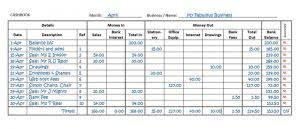Content

These bonds are subject to federal tax, but some are exempt from state and local taxes. The bond market tends to move inversely with interest rates because bonds will trade at a discount when interest rates are rising and at a premium when interest rates are falling. For retirees or other individuals who like the idea of receiving regular income, bonds can be a solid asset to own. Each bond has a certain par value (say, $1,000) and pays a coupon to investors. For instance, a $1,000 bond with a 4% coupon would pay $20 to the investor twice per year ($40 annually) until it matures. Those with a large stake in a company will often take advantage of their rights as shareholders to help guide a company toward (hopefully) more growth.
At any time, a bondholder can sell their bonds in the open market, where the price can fluctuate, sometimes dramatically. The investors who purchased a convertible bond may think this is a great solution because they can profit from the upside in the stock if the project is successful. They are taking more risk by accepting a lower coupon payment, but the potential reward if the bonds are converted could make that trade-off acceptable. Many corporate and government bonds are publicly traded; others are traded only over-the-counter (OTC) or privately between the borrower and lender. Bond details include the end date when the principal of the loan is due to be paid to the bond owner and usually include the terms for variable or fixed interest payments made by the borrower. And even though bonds are a much safer investment than stocks, they still carry some risks, like the possibility that the borrower will go bankrupt before paying off the debt.
Comparing Stocks and Bonds
The investor should buy a wide variety of stocks and bonds using some of the factors listed above. With bonds, prices are determined based on how ratings companies, like S&P and Fitch, rate the creditworthiness of the issuer of the bond. For example, a corporate bond issued by Apple is rated AAA, which means the ratings agency has very high confidence in the ability of Apple to repay its loan, the bond debt that the bondholders own.
Bonds are useful as a counterweight to the rapid price swings of stocks, but generally should not make up your entire portfolio. Bonds are not as easily tradable as stocks, in part because they don’t trade on exchanges and in part because each bond has a unique term to maturity. During that time, changing interest rates can affect the price of a bond. If an investor wants to sell a bond before its maturity date and is able to find a buyer on the much thinner market for bonds, they may not make their initial investment back. Depending on the financial strength and creditworthiness of the issuer, bonds can be very safe or more risky, and investors are paid a premium in higher yield based on that risk. Stocks can also be great ways to generate income, typically via dividends, or cash paid by a company directly to shareholders.
How do I buy stocks?
Because of this, bonds are often good for investors who are seeking income and who want to preserve capital. In general, experts advise that as individuals get older or approach retirement, they should shift their portfolio weights more towards bonds. Bonds are sold for a fixed term, typically from one year to 30 years. You can sell a bond on the secondary market before it matures, but you run the risk of not making back your original investment, or principal.
- Companies may issue shares to the public for several reasons, but the most common is to raise cash that can be used to fuel future growth.
- Stocks are beneficial for investors who have a higher risk appetite.
- Conversely, shareholders often receive nothing in the event of bankruptcy, implying that stocks are inherently riskier investments than bonds.
- Moreover, markets allow lenders to sell their bonds to other investors or to buy bonds from other individuals—long after the original issuing organization raised capital.
- We believe everyone should be able to make financial decisions with confidence.
A mortgage bond is a type of security backed by pooled mortgages, paying interest to the holder monthly, quarterly, define stocks and bonds or semi-annually. Our partners cannot pay us to guarantee favorable reviews of their products or services.
Bond Yields vs. Prices
They are also called fixed-income instruments because they provide a fixed amount of return, which comes in the form of interest. The first common stock ever issued was by the Dutch East India Company in 1602. Individual (or ‘Retail‘) investors also account for a large proportion of Stock and Bond ownership.
- Most investors need to own both stocks and bonds to build wealth over time, but your age and the timing of your financial goals will help determine the best mix for you.
- If you’re a young investor who has a lot of time, you can benefit in a weak market.
- In the U.S., investment-grade bonds can be broadly classified into four types—corporate, government, agency and municipal bonds—depending on the entity that issues them.
- Those who do, include large institutional investors like pension funds foundations, and endowments, as well as investment banks, hedge funds, and asset management firms.
- The interest rate is termed the _coupon_ of the bond, expressed as a percentage yield.
- As the Buyer, we must fund the rest of the purchase by making a Down Payment.
